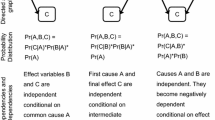Abstract
Two kinds of causal inference rules which are widely used by social scientists are investigated. Two conceptions of causation also widely used are explicated — the INUS and probabilistic conceptions of causation. It is shown that the causal inference rules which link correlation, a kind of partial correlation, and a conception of causation areinvalid. It is concluded anew methodology is required for causal inference.
Similar content being viewed by others
References
Asher, H. B.: 1976,Causal Modeling, Sage Publications, Beverly Hills, California.
Bentler, P. M.: 1980, ‘Multivariate analysis with latent variables: causal modeling’,Annual Review of Psychology 31.
Blalock, H. M.: 1967, ‘Causal inferences, closed populations, and measures of association’,American Political Science Review 61. [Also in H. M. Blalock (ed.) (1971) below.]
Blalock, H. M. (ed.): 1971,Causal Models in the Social Sciences, Aldine Publ. Co., Chicago.
Blalock, H. M.: 1972,Causal Inferences in Nonexperimental Research, W. W. Norton, New York.
Cook, T. D. and Campbell, D. T.: 1979,Quasi-Experimentation: Design and Analysis Issues for Field Settings, Rand McNally, Chicago.
Davis, J. A.: 1976, ‘Analyzing contingency tables with linear flow graphs: 0-systems’, in D. R. Heise (ed.),Sociological Methodology, Jossey-Bass Publications, San Francisco, pp. 111–45.
Duncan, O. D.: 1966, ‘Path analysis: sociological examples’,American Journal of Sociology 72. [Also in H. M. Blalock (ed.) (1971).]
Duncan, O. D.: 1975,Introduction to Structural Equation Models, Academic Press, New York.
Ellett, F. S., Jr. and Ericson, D. P.: forthcoming, ‘Correlation, partial correlation, and causation’,Philosophy of Science.
Good, I. J.: 1962, ‘A causal calculus I-II’,British Journal for the Philosophy of Science XI, 44, 1961 andXII, 45.
Kendall, P. and Lazarsfeld, P. F.: 1950, ‘Problems of survey analysis’, in R. K. Merton and P. F. Lazarsfeld (eds.),Continuities in Social Research: Studies in the Scope and Methods of “The American Soldier”, Free Press, Glencoe, Illinois, pp. 133–96.
Kenny, D. A.: 1979,Correlation and Causation, John Wiley and Sons, New York.
Mackie, J. L.: 1974,The Cement of the Universe, Oxford University Press, Oxford.
Nagel, E.: 1961,The Structure of Science, Harcourt, Brace and World, New York.
Reichenbach, H.: 1956,The Direction of Time, University of California Press, Berkeley.
Salmon, W. C.: 1980, ‘Probabilistic causality’,Pacific Philosophical Quarterly 61, 112.
Simon, H. A.: 1957,Models of Man, John Wiley and Sons, New York.
Suppes, P.: 1970,A Probabilistic Theory of Causation, North-Holland, Amsterdam.
Wright, S.: 1971, ‘Path coefficients and path regressions,Alternative or Complementary Concepts?’, [in H. M. Blalock (ed.) above].
Author information
Authors and Affiliations
Rights and permissions
About this article
Cite this article
Ellett, F.S., Ericson, D.P. The logic of causal methods in social science. Synthese 57, 67–82 (1983). https://doi.org/10.1007/BF01064068
Issue Date:
DOI: https://doi.org/10.1007/BF01064068




